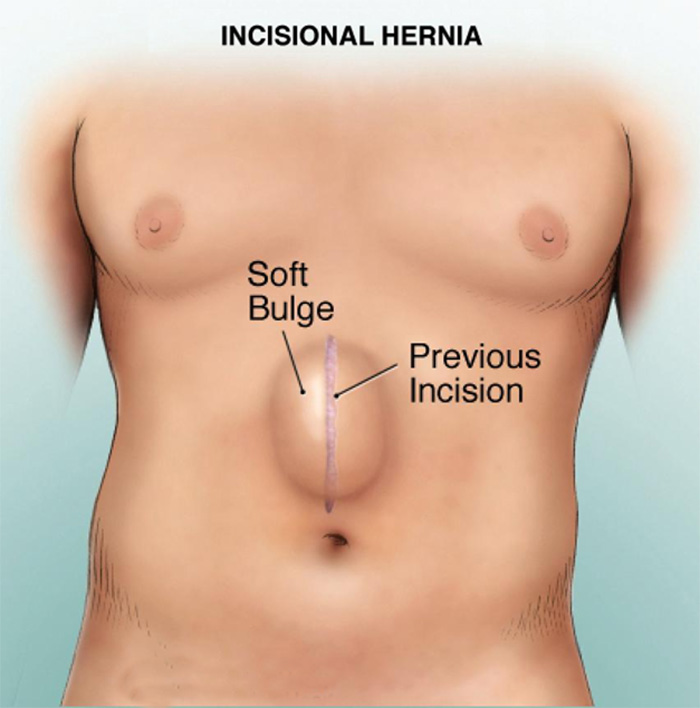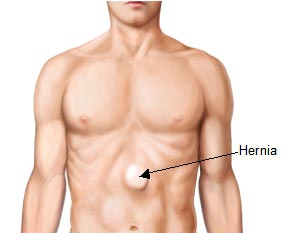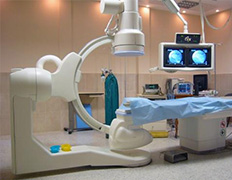Hernia
A hernia occurs when an organ pushes through an opening in the muscle or tissue that holds it in place. For example, the intestines may break through a weakened area in the abdominal wall.
What Is a Hernia?
Hernias are most common in the abdomen. However, they can also appear in the upper thigh, belly button, and groin regions. Though the majority of hernias are not immediately life threatening, they will not go away on their own and will require surgical correction to prevent potentially dangerous complications.

Common Hernia Types
Inguinal
Inguinal hernias are the most common type of hernia. They make up about 70 percent of all hernias, according to the British Hernia Centre (BHC). These hernias occur when the intestines push through a weak spot or tear in the lower abdominal wall, often in the inguinal canal.
The inguinal canal is found in the groins of both men and women. In men, it is the area where the spermatic chord passes from the abdomen to the scrotum. This chord holds up the testicles. In women, the inguinal canal contains a ligament that helps to hold the uterus in place.
This type of hernia is more common in men than in women. This is because a man’s testicles descend through the inguinal canal shortly after birth, and the canal is supposed to close almost completely behind them. Sometimes, the canal does not close properly, leaving a weakened spot prone to hernias.
Hiatal
A hiatal hernia occurs when part of your stomach protrudes up through the diaphragm into the chest. The diaphragm is a sheet of muscle that helps you breathe by contracting, drawing air into the lungs. It separates the organs in your abdomen from those in your chest.
This type of hernia is most common in patients over 50 years old. If a child has the condition, it is typically caused by a congenital (birth) defect. Hiatal hernias almost always cause gastroesophageal reflux (when the stomach contents leak backward into the esophagus, causing a burning sensation).
Umbilical
Umbilical hernias occur in babies and children under six months of age if their intestines bulge through the abdominal wall near the bellybutton. Parents may notice a bulge in or near their child’s bellybutton, especially when the child is crying.
An umbilical hernia is the only kind that usually goes away on its own, typically by the time the child is one year old. If the hernia has not gone away by this point, surgery may be used to correct it.
Incisional
Incisional hernias can occur after you have abdominal surgery. Your intestines may push through the incision scar or the surrounding, weakened tissue.
What Causes a Hernia?
Hernias are caused by a combination of muscle weakness and strain. A hernia can develop quickly or over a long period of time, depending on its cause.
Common causes of muscle weakness include:
- failure of the abdominal wall to close properly in the womb (congenital defect)
- age
- chronic coughing
- damage from injury or surgery
Factors that strain your body and may cause a hernia (especially if your muscles are weak) include:
- being pregnant (puts pressure on your abdomen)
- being constipated (causes you to strain when having a bowel movement)
- heavy weight lifting
- fluid in the abdomen (ascites)
- suddenly gaining weight
- persistent coughing or sneezing
- Hernias are caused by a combination of muscle weakness and strain. A hernia can develop quickly or over a long period of time, depending on its cause.
Common causes of muscle weakness include:
- failure of the abdominal wall to close properly in the womb (congenital defect)
- age
- chronic coughing
- damage from injury or surgery
Factors that strain your body and may cause a hernia (especially if your muscles are weak) include:
- being pregnant (puts pressure on your abdomen)
- being constipated (causes you to strain when having a bowel movement)
- heavy weight lifting
- fluid in the abdomen (ascites)
- suddenly gaining weight
- persistent coughing or sneezing
Am I At Risk for a Hernia?
Several factors increase your risk of developing a hernia, including:
- a personal or family history of hernias
- being overweight or obese
- a chronic cough
- chronic constipation
- smoking (which can trigger a chronic cough)
 Conditions such as cystic fibrosis can also indirectly increase your risk of developing a hernia. Cystic fibrosis impairs the function of the lungs, causing a chronic cough.
Conditions such as cystic fibrosis can also indirectly increase your risk of developing a hernia. Cystic fibrosis impairs the function of the lungs, causing a chronic cough.
Several factors increase your risk of developing a hernia, including:
- a personal or family history of hernias
- being overweight or obese
- a chronic cough
- chronic constipation
- smoking (which can trigger a chronic cough)
Conditions such as cystic fibrosis can also indirectly increase your risk of developing a hernia. Cystic fibrosis impairs the function of the lungs, causing a chronic cough.
What Are the Symptoms of a Hernia?
The most common symptom of a hernia is a bulge or lump in the affected area. In the case of an inguinal hernia, you may notice a lump on either side of your pubic bone where your groin and thigh meet. You’re more likely to feel your hernia through touch when you are standing up.
If your baby has a hernia, you may only be able to feel the bulge when he or she is crying. A bulge is typically the only symptom of an umbilical hernia.
Other common symptoms of an inguinal hernia include:
- pain or discomfort in the affected area (usually the lower abdomen), especially when bending over, coughing, or lifting
- weakness, pressure, or a feeling of heaviness in the abdomen
- a burning, gurgling, or aching sensation at the site of the bulge
Other symptoms of a hiatal hernia include:
- acid reflux (when stomach acid moves backwards into the esophagus causing a burning sensation)
- chest pain
- difficulty swallowing
In some cases, hernias have no symptoms. You may not know you have a hernia unless it shows up during a routine physical or a medical exam for an unrelated problem.
The most common symptom of a hernia is a bulge or lump in the affected area. In the case of an inguinal hernia, you may notice a lump on either side of your pubic bone where your groin and thigh meet. You’re more likely to feel your hernia through touch when you are standing up.
If your baby has a hernia, you may only be able to feel the bulge when he or she is crying. A bulge is typically the only symptom of an umbilical hernia.
Other common symptoms of an inguinal hernia include:
- pain or discomfort in the affected area (usually the lower abdomen), especially when bending over, coughing, or lifting
- weakness, pressure, or a feeling of heaviness in the abdomen
- a burning, gurgling, or aching sensation at the site of the bulge
Other symptoms of a hiatal hernia include:
- acid reflux (when stomach acid moves backwards into the esophagus causing a burning sensation)
- chest pain
- difficulty swallowing
In some cases, hernias have no symptoms. You may not know you have a hernia unless it shows up during a routine physical or a medical exam for an unrelated problem.
How Is a Hernia Diagnosed?
Your doctor will likely diagnose an inguinal or incisional hernia by performing a physical examination. Your doctor may feel for a bulge in your abdomen or groin that gets larger when you stand, cough, or strain.
If you have a hiatal hernia, it may be diagnosed with a barium X-ray or endoscopy. These tests allow your doctor to see the location of your stomach inside your body. A barium X-ray is a series of X-ray pictures of your digestive tract that are recorded after you’ve drunk a liquid solution containing barium, which shows up well on X-ray images. An endoscopy involves threading a small camera attached to a tube down your throat and into your esophagus and stomach.
If your child has an umbilical hernia, your doctor may perform an ultrasound. An ultrasound uses high-frequency sound waves to create an image of the structures inside the body.
Surgery and Treatment Options for Hernias
Based on the size of your hernia and the severity of your symptoms, you may not need treatment. Your doctor may simply monitor your hernia for possible complications.
The symptoms of a hiatal hernia can often be treated by simply changing your diet. Avoid large or heavy meals, don’t lie down or bend over after a meal, and keep your body weight in a healthy range. If these changes in diet do not eliminate your discomfort, you may need surgery to correct the hernia.
If your hernia is growing larger or causing you pain, your doctor may decide that it’s best to operate. Your doctor may repair your hernia by sewing the hole in the abdominal wall closed during surgery. However, the more common treatment for hernias is to patch the hole with surgical mesh.
Hernias can be repaired with either open or laparoscopic surgery. Laparoscopic surgery uses a tiny camera and miniaturized surgical equipment to repair the hernia using only a few small incisions. Laparoscopic surgery is less damaging to the surrounding tissue.
Open surgery requires a longer recovery process. You may be unable to move around normally for up to six weeks. Laparoscopic surgery has a much shorter recovery time. However, the risk of your hernia reoccurring is higher. In addition, not all hernias are suitable for laparoscopic repair, including those in which a portion of your intestines has moved down into the scrotum.
Based on the size of your hernia and the severity of your symptoms, you may not need treatment. Your doctor may simply monitor your hernia for possible complications.
The symptoms of a hiatal hernia can often be treated by simply changing your diet. Avoid large or heavy meals, don’t lie down or bend over after a meal, and keep your body weight in a healthy range. If these changes in diet do not eliminate your discomfort, you may need surgery to correct the hernia.
If your hernia is growing larger or causing you pain, your doctor may decide that it’s best to operate. Your doctor may repair your hernia by sewing the hole in the abdominal wall closed during surgery. However, the more common treatment for hernias is to patch the hole with surgical mesh.
Hernias can be repaired with either open or laparoscopic surgery. Laparoscopic surgery uses a tiny camera and miniaturized surgical equipment to repair the hernia using only a few small incisions. Laparoscopic surgery is less damaging to the surrounding tissue.
Open surgery requires a longer recovery process. You may be unable to move around normally for up to six weeks. Laparoscopic surgery has a much shorter recovery time. However, the risk of your hernia reoccurring is higher. In addition, not all hernias are suitable for laparoscopic repair, including those in which a portion of your intestines has moved down into the scrotum.
Potential Complications of a Hernia
If left untreated, your hernia will probably grow larger and more painful. A portion of your intestine could become trapped, or “incarcerated,” in the abdominal wall. This can obstruct your bowel, causing severe pain, nausea, and constipation.
If the trapped section of intestine cannot receive enough blood flow, “strangulation” occurs. This can cause the intestinal tissue to become infected or die and is a life threatening medical emergency.
If left untreated, your hernia will probably grow larger and more painful. A portion of your intestine could become trapped, or “incarcerated,” in the abdominal wall. This can obstruct your bowel, causing severe pain, nausea, and constipation.
If the trapped section of intestine cannot receive enough blood flow, “strangulation” occurs. This can cause the intestinal tissue to become infected or die and is a life threatening medical emergency.
Preventing a Hernia
You can’t always prevent the muscle weakness that allows a hernia to occur. However, you can reduce the amount of strain you place on your body. This may help you avoid a hernia or keep an existing hernia from getting worse. Prevention tips include:
- not smoking
- seeing your doctor when you are sick to avoid developing a persistent cough
- maintaining a healthy body weight
- avoiding straining during bowel movements or urination
- not lifting weights that are too heavy for you and lifting with your knees, not your back.
Our Expertise in Medical Services
Rana Hospital was started with a dream of providing the best facilities for Piles, Fissures, Fistula and all Anorectal problems.

Mon to Sat:
8:30 AM – 1:30 PM
4:00 PM – 6:30 PM
Mon to Sat:
9:00 AM – 1:30 PM
4:00 PM – 6:30 PM
Make an Appointment
 Accreditation & Awards
Accreditation & Awards
The Hospital organized a free checkup camp for PILES on 24th October 2013 in which 717 patients from all over India were examined. It was followed by one day free operation camp on 27th October 2013. Dr Suri single-handedly performed 391 free surgeries in 8 hours & 45 minutes setting a World Record.




